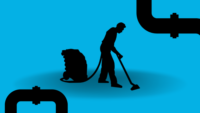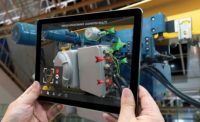On virtually every regulatory inspection checklist is an item called lighting. To most sanitarians, the primary focus in the evaluation of lighting is assuring that bulbs, tubes and other glass lamps are protected against glass breakage or constructed from materials that reduce the likelihood of breakage. Obviously, this is an effective strategy to prevent glass shards from contaminating food in the event of an unfortunate incident. While protection against glass breakage is important, I am always amused that it is the most frequently cited violation, and yet, I find nothing in the literature indicating that this rises anywhere to the level of hazard posed by foodborne infections.
The secondary emphasis in most code enforcement is light intensity. In my own practice, I have come to appreciate this aspect of regulation to a greater degree because proper illumination in the preparation and production areas is absolutely critical to food protection, sanitation and employee safety. Numerous bruised shins from pallets stored in dark locations and ungraceful yet comedic landings on wet, slick floors stand as historic testimony to my bias.
While the Food Code specifies a few lighting intensities for specific work areas, the current Good Manufacturing Practices (cGMPs) only requires “adequate illumination,” whatever that means. Therefore, apart from citing the occasional burned-out bulb in a walk-in refrigerator or storage room, the broader evaluation of lighting has eluded the regulatory community. While conducting instrumentation workshops for sanitarians over the past decade, I have learned that very few of my colleagues actually carry a light meter in their field inspection kit, even though the light meter is a recommended tool according to the Code. I have also learned that we are not well versed in understanding the language of lighting—or its concepts and measurements. Because lighting is the one thing that we can most easily modify in any physical plant, I urge that we collectively reexamine this critical issue.
Food Code Lighting Requirements
The basic Food Code lighting intensity requirements encompass the following three criteria:
• The first requirement specifies providing at least 110 lux (10-ft. candles) at a distance of 75 cm (30 inches) above the floor, in walk-in refrigeration units and dry food storage areas and in other areas and rooms during periods of cleaning.
• The second light intensity requirement calls for at least 220 lux (20-ft. candles) where food is provided for self-service or where packaged foods are sold or offered for consumption, as well as inside equipment such as reach-in and under-counter refrigerators. It goes on to specify 220 lux, measured at a distance of 75 cm (30 inches) above the floor in areas used for handwashing, warewashing, equipment and utensil storage, and in toilet rooms.
• The third Food Code criteria requires at least 540 lux (50-foot candles) at a surface where a food employee is working with food or working with utensils or equipment such as knives, slicers, grinders or saws where employee safety is a factor. It really does not address light quality, directionality or other components of illumination related to our visual acuity and factors necessary to maintain proper food safety and sanitation. In short, if you can’t properly see it, it probably isn’t clean or safe.
The Code does not specify the conditions of operation under which light intensity measurements are taken. For instance, the light intensity on a work surface may vary significantly when taken under static conditions, as opposed to taking the measurement when an employee is working at that same site or moving from one task area to another. Under these dynamic conditions, a light source positioned at the employee’s back may cast a shadow on the task area or path of travel. As an aside, this is also a significant consideration in many of the older walk-in refrigerators and refrigerated rooms where the light source is situated by the entryway or door.
A Scientific Approach to Lighting
The food industry uses the science of lighting in its marketing strategy quite effectively. I certainly appreciate the fine art of skillfully designing and crafting restaurant lighting to set the mood for the diner. This is true in both sit-down and fast food establishments. From evoking a romantic eating experience to that of a carnival-like atmosphere, lighting sets the proper mood and few expenses are spared toward that goal. Likewise, in many food processing plants, the lobby areas, conference rooms and executive suites are illuminated with meticulous detail for the comfort of buyers and vendors. Outside lighting for safety and security is certainly a critical component of risk management and loss prevention. As such, virtually every parking area and entryway to restaurants and food processing plants are appropriately illuminated.
However, in going into the back rooms of restaurant kitchens and food production areas, the quality of lighting is often overlooked. More often than not, the industrial lighting is not selected for the quality of its light and is laid out in a geometric pattern without regard to employee movement and tasks. This creates conditions under which shadows, glare and contrast interfere with visibility. While the spirit of the Code is met in light intensity, we often do not consider such concepts and measurements as:
Color Rendering Index (CRI). This measurement of an object’s colors is determined by the light under which they are viewed in comparison to colors produced under an ideal “black body” radiator. This is important in a processing or food preparation environment, particularly where a single color is dominant. The most dramatic effect of this concept can be seen at any supermarket meat and deli counter where the CRI of the light sources enhance the color of the products being sold.
Contrast. This is the relationship between the brightness of an object and its immediate background. This is important in sanitation and safety operations where visibility plays a significant role.
Glare. This is unshielded light from a luminaire or lamp. In extreme cases, glare can compromise safety, particularly in a wet environment or one in which there is unguarded equipment.
Intensity. This is the amount of light emitted by a source in a particular direction; the unit of measure is candela (cd). This relates to task lighting and ultimately:
productivity. Task lighting should be age-sensitive and take into account the detail of the work. Refinements of light intensity criteria are well defined by the Illuminating Engineering Society of North America (IESNA) through its many publications.
Luminance. Also known as “brightness,” luminance denotes the intensity per square area of light from a source or from an illuminated surface, taking into consideration the reflectance characteristics. The luminance ratio measures the task surface to the background. This becomes significant in any area where stainless steel and polished surfaces dominate.
This list is by no means complete, but it should give some idea that lighting detail in the production and food handling areas really is important in achieving food protection and safety objectives.
Objectives of a Lighting Program
Industrial lighting consultants often can increase productivity, enhance safety and augment sanitation with minor modifications to the existing lighting system—with an eye toward economy. We can begin improving lighting by developing a plan that provides guidelines for the safety and comfort of employees and the enhancement of the physical environment. Using examples from the health care industry, Jakob Olree and Michael Barber, facilities and lighting professionals, outlined a successful lighting program in an article titled “Illuminating Ideas,” which was published in the July 2005 issue of Health Facilities Management magazine. While the article itself details a 10-step guide to develop a lighting program, I have taken some liberties with their objectives to tailor them more to food production and preparation areas, but the concepts remain the same, namely:
1. Provide a safe and welcoming work environment. Lighting creates an emotional response. This is true within the work environment, where employees spend the better part of the day. Lighting communicates warmth, clarity and mirrors sanitation. Likewise, task and general lighting in the kitchen or production, receiving and storage areas effects staff productivity and worker safety through a balance of brightness, contrast and revealing the form of the space and creating a balance of brightness and color rendition.
2. Optimize visibility. The distribution and intensity of light affects visibility and promotes visual comfort. Visibility is affected by the lighting characteristics that are listed above, and include the amount and distribution of light, ratios of luminance or brightness, the color quality of light and control of light source glare. Lighting designs that incorporate these criteria support a clean, productive and safe environment.
3. Provide safe and efficient traffic patterns. Complement the facility’s architecture. Light intensity and color (daylight, bright white, etc.), as well as the placement of luminaries where the most light is needed, such as task areas and along the paths of travel in the production and storage areas of the restaurant or food plant, should provide for improved safety and the enhancement of sanitation. Likewise, lighting levels, fixture placement and lighting color should flow in a logical progression that helps to make the facility an easy and safe place to navigate.
Not all areas are required to be lighted with equal intensity. Given the same number of luminaries that would normally be placed in a geometric pattern, their placement or rearrangement can optimize visibility by situating the luminaries according to materiel flow and task areas.
4. Minimize operating costs. For obvious economic reasons, the lighting design should minimize the variety of lamp types; maximize the life and accessibility of all lighting components to promote good maintenance, and apply energy frugality to reduce operating costs. As a secondary economic benefit, the quality of lighting will enhance sanitation, thereby affecting risk management, as well as impacting loss prevention, which in turn, should reduce the worker injury rate and the cost of insurance.
Forensic sanitarian Robert W. Powitz, Ph.D., MPH, RS, CFSP, is principal consultant and technical director of Old Saybrook, CT-based R.W. Powitz & Associates, a professional corporation of forensic sanitarians who specialize in environmental and public health litigation support services to law firms, insurance companies, governmental agencies and industry. For more than 12 years, he was the Director of Environmental Health and Safety for Wayne State University in Detroit, MI, where he continues to hold the academic rank of adjunct professor in the College of Engineering. He also served as Director of Biological Safety and Environment for the U.S. Department of Agriculture at the Plum Island Animal Disease Center at Greenport, NY. He can be reached at sanitarian@juno.com.
Shedding Light on the Art and Science of Lighting




